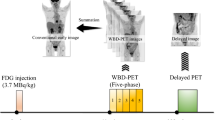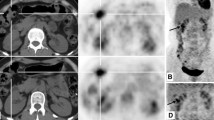Abstract
Purpose
To comparatively evaluate the diagnostic performances of total-body 18F-fluorodeoxyglucose positron-emission tomography/computed tomography (18F-FDG PET/CT) with fast 2-min acquisition and conventional PET/CT in liver cancer patients.
Methods
This study included 156 patients with liver tumours. Seventy-eight patients underwent total-body PET/CT. PET raw data were reconstructed using acquisition durations of 2 min (G2) and 15 min (G15). Another 78 patients with liver lesions (control patients) underwent conventional uMI780 PET/CT (G780). All patients were evaluated based on TNM staging. The maximum tumour standardized uptake value (tumour SUVmax), mean normal liver SUV (SUVmean), and tumour SUVmax-to-liver SUVmean ratio (TLR) were determined for all patients. G15 data were used as the reference in the lesion detectability analysis. The diagnostic performances of PET/CT in terms of visual parameters and of PET in terms of semi-quantitative parameters such as SUVmax and TLR were evaluated. Receiver operating characteristics (ROC) curve analysis of SUVmax and TLR at G2 was performed. Pathologic findings of surgical specimens served as the gold standard for all patients.
Results
The lesions found in G15 were also noted in G2; three lymph nodes were missed in G2. However, no significant difference was found in the TNM stage among G2, G15, and G780. For benign and malignant lesions, the liver SUVmean in G2 and G15 was higher than that in G780 (all P < 0.05). The tumour SUVmax and TLR in G2 were equivalent to those in G15 and G780 regardless of whether the lesions were benign or malignant. ROC curve analysis (SUVmax cutoff: 4.34, TLR cutoff: 1.34) demonstrated that G2 also had good sensitivity in detecting liver cancer.
Conclusion
The diagnostic performance of total-body PET/CT in G2 was comparable to that in G15 among liver cancer patients. Further, the diagnostic efficiency of total-body PET/CT imaging with fast 2-min acquisition and conventional PET/CT was similar.



Similar content being viewed by others
References
Bray F, Ferlay J, Soerjomataram I, Siegel RL, Torre LA, Jemal A. Global cancer statistics 2018: GLOBOCAN estimates of incidence and mortality worldwide for 36 cancers in 185 countries. CA Cancer J Clin. 2018;68(6):394–424. https://doi.org/10.3322/caac.21492.
Anwanwan D, Singh SK, Singh S, Saikam V, Singh R. Challenges in liver cancer and possible treatment approaches. Biochimica Biophysica Acta Rev Cancer. 2020;1873(1):188314. https://doi.org/10.1016/j.bbcan.2019.188314.
Starley BQ, Calcagno CJ, Harrison SA. Nonalcoholic fatty liver disease and hepatocellular carcinoma: a weighty connection. Hepatology. 2010;51(5):1820–32. https://doi.org/10.1002/hep.23594.
Zhou M, Wang H, Zeng X, Yin P, Zhu J, Chen W, et al. Mortality, morbidity, and risk factors in China and its provinces, 1990–2017: a systematic analysis for the Global Burden of Disease Study 2017. The Lancet. 2019;394(10204):1145–58. https://doi.org/10.1016/S0140-6736(19)30427-1.
Benson AB, D’Angelica MI, Abbott DE, Abrams TA, Alberts SR, Anaya DA, et al. Guidelines insights: hepatobiliary cancers, version 2.2019. J Natl Compr Canc Netw. 2019;17(4):302–10. https://doi.org/10.6004/jnccn.2019.0019.
Ayuso C, Rimola J, Vilana R, Burrel M, Darnell A, Garcia-Criado A, et al. Diagnosis and staging of hepatocellular carcinoma (HCC): current guidelines. Eur J Radiol. 2018;101:72–81. https://doi.org/10.1016/j.ejrad.2018.01.025.
Na SJ, Oh JK, Hyun SH, Lee JW, Hong IK, Song B, et al. 18F-FDG PET/CT can predict survival of advanced hepatocellular carcinoma patients: a multicenter retrospective cohort study. J Nucl Med. 2017;58(5):730–6. https://doi.org/10.2967/jnumed.116.182022.
Lee SM, Kim HS, Lee S, Lee JW. Emerging role of (18)F-fluorodeoxyglucose positron emission tomography for guiding management of hepatocellular carcinoma. World J Gastroenterol. 2019;25(11):1289–306. https://doi.org/10.3748/wjg.v25.i11.1289.
Lu R, She B, Gao W, Ji Y, Xu D, Wang Q, et al. Positron-emission tomography for hepatocellular carcinoma: current status and future prospects. World J Gastroentero. 2019;25(32):4682–95. https://doi.org/10.3748/wjg.v25.i32.4682.
Schiller F, Frings L, Thurow J, Meyer PT, Mix M. Limits for reduction of acquisition time and administered activity in (18)F-FDG PET studies of Alzheimer dementia and frontotemporal dementia. J Nucl Med. 2019;60(12):1764–70. https://doi.org/10.2967/jnumed.119.227132.
Boellaard R, Delgado-Bolton R, Oyen WJG, Giammarile F, Tatsch K, Eschner W, et al. FDG PET/CT: EANM procedure guidelines for tumour imaging: version 2.0. Eur J Nucl Med Mol I. 2015;42(2):328–54. https://doi.org/10.1007/s00259-014-2961-x.
Spencer BA, Berg E, Schmall JP, Omidvari N, Leung EK, Abdelhafez YG, et al. Performance evaluation of the uEXPLORER total-body PET/CT scanner based on NEMA NU 2–2018 with additional tests to characterize PET scanners with a long axial field of view. J Nucl Med. 2021;62(6):861–70. https://doi.org/10.2967/jnumed.120.250597.
Liu G, Hu P, Yu H, Tan H, Zhang Y, Yin H, et al. Ultra-low-activity total-body dynamic PET imaging allows equal performance to full-activity PET imaging for investigating kinetic metrics of 18F-FDG in healthy volunteers. Eur J Nucl Med Mol I. 2021. https://doi.org/10.1007/s00259-020-05173-3.
Tan H, Sui X, Yin H, Yu H, Gu Y, Chen S, et al. Total-body PET/CT using half-dose FDG and compared with conventional PET/CT using full-dose FDG in lung cancer. Eur J Nucl Med Mol I. 2021;48(6):1966–75. https://doi.org/10.1007/s00259-020-05091-4.
Zhang Y, Hu P, Wu R, Gu Y, Chen S, Yu H, et al. The image quality, lesion detectability, and acquisition time of 18F-FDG total-body PET/CT in oncological patients. Eur J Nucl Med Mol I. 2020;47(11):2507–15. https://doi.org/10.1007/s00259-020-04823-w.
Hu P, Zhang Y, Yu H, Chen S, Tan H, Qi C, et al. Total-body (18)F-FDG PET/CT scan in oncology patients: how fast could it be? Eur J Nucl Med Mol I. 2021;48(8):2384–94. https://doi.org/10.1007/s00259-021-05357-5.
Lamarca A, Santos Laso A, Utpatel K, la Casta A, Stock S, Forner A, et al. Liver metastases of intrahepatic cholangiocarcinoma: implications for an updated staging system. Hepatology (Baltimore, Md). 2021;73(6):2311–25. https://doi.org/10.1002/hep.31598.
Amin MB, Greene FL, Edge SB, Compton CC, Gershenwald JE, Brookland RK, et al. The eighth edition AJCC cancer staging manual: continuing to build a bridge from a population-based to a more “personalized” approach to cancer staging. CA Cancer J Clin. 2017;67(2):93–9. https://doi.org/10.3322/caac.21388.
Liu C, Pierce Ii LA, Alessio AM, Kinahan PE. The impact of respiratory motion on tumor quantification and delineation in static PET/CT imaging. Phys Med Biol. 2009;54(24):7345–62. https://doi.org/10.1088/0031-9155/54/24/007.
Nehmeh SA, Erdi YE. Respiratory motion in positron emission tomography/computed tomography: a review. Semin Nucl Med. 2008;38(3):167–76. https://doi.org/10.1053/j.semnuclmed.2008.01.002.
Zhang X, Zhou J, Cherry SR, Badawi RD, Qi J. Quantitative image reconstruction for total-body PET imaging using the 2-meter long EXPLORER scanner. Phys Med Biol. 2017;62(6):2465–85. https://doi.org/10.1088/1361-6560/aa5e46.
Zhang X, Cherry SR, Xie Z, Shi H, Badawi RD, Qi J. Subsecond total-body imaging using ultrasensitive positron emission tomography. Proc Natl Acad Sci PNAS. 2020;117(5):2265–7. https://doi.org/10.1073/pnas.1917379117.
Badawi RD, Shi H, Hu P, Chen S, Xu T, Price PM, et al. First human imaging studies with the EXPLORER total-body PET scanner. J Nucl Med. 2019;60(3):299–303. https://doi.org/10.2967/jnumed.119.226498.
Pantel AR, Viswanath V, Daube-Witherspoon ME, Dubroff JG, Muehllehner G, Parma MJ, et al. PennPET explorer: human imaging on a whole-body imager. J Nucl Med. 2020;61(1):144–51. https://doi.org/10.2967/jnumed.119.231845.
Xiao J, Yu H, Sui X, Hu Y, Cao Y, Liu G, et al. Can the BMI-based dose regimen be used to reduce injection activity and to obtain a constant image quality in oncological patients by (18)F-FDG total-body PET/CT imaging? Eur J Nucl Med Mol Imaging. 2021;49(1):269–78. https://doi.org/10.1007/s00259-021-05462-5.
Tan H, Sui X, Yin H, Yu H, Gu Y, Chen S, et al. Total-body PET/CT using half-dose FDG and compared with conventional PET/CT using full-dose FDG in lung cancer. Eur J Nucl Med Mol. 2020 Nov;I(2020):27. https://doi.org/10.1007/s00259-020-05091-4.
Mawlawi O, Erasmus JJ, Pan T, Cody DD, Campbell R, Lonn AH, et al. Truncation artifact on PET/CT: impact on measurements of activity concentration and assessment of a correction algorithm. AJR Am J Roentgenol. 2006;186(5):1458–67. https://doi.org/10.2214/AJR.05.0255.
Funding
This study is supported by the National Science Foundation for Scholars of China (Grant No. 81871407 to H.C.S.) and Shanghai Municipal Key Clinical Specialty (No. shslczdzk03401), Three-year Action Plan of Clinical Skills and Innovation of Shanghai Hospital Development Center (No. SHDC2020CR3079B to H.C.S.), the Shanghai Science and Technology Committee (No. 20DZ2201800), Three-year Action Plan for the fifth round of public health system construction in Shanghai (No. GWV-10.1-XK10), and Next Generation Information Infrastructure Construction Project (No. 201901014).
Author information
Authors and Affiliations
Contributions
We acknowledge the contributions of all members involved in this article. Y.H. and H.C.S. contributed to the study design. Y.H. and G.B.L. contributed to the data processing and analysis. H.J.Y contributed to the image acquisition and processing. Y.H. and H.C.S. contributed to the manuscript drafting. J.Y.G and H.C.S. contributed to the article revising. All authors discussed and approved the final manuscript.
Corresponding authors
Ethics declarations
Conflict of interest
The authors declare no competing interests.
Additional information
Publisher's Note
Springer Nature remains neutral with regard to jurisdictional claims in published maps and institutional affiliations.
This article is part of the Topical Collection on Oncology – General.
Supplementary Information
Below is the link to the electronic supplementary material.
Rights and permissions
About this article
Cite this article
Hu, Y., Liu, G., Yu, H. et al. Diagnostic performance of total-body 18F-FDG PET/CT with fast 2-min acquisition for liver tumours: comparison with conventional PET/CT. Eur J Nucl Med Mol Imaging 49, 3538–3546 (2022). https://doi.org/10.1007/s00259-022-05772-2
Received:
Accepted:
Published:
Issue Date:
DOI: https://doi.org/10.1007/s00259-022-05772-2




